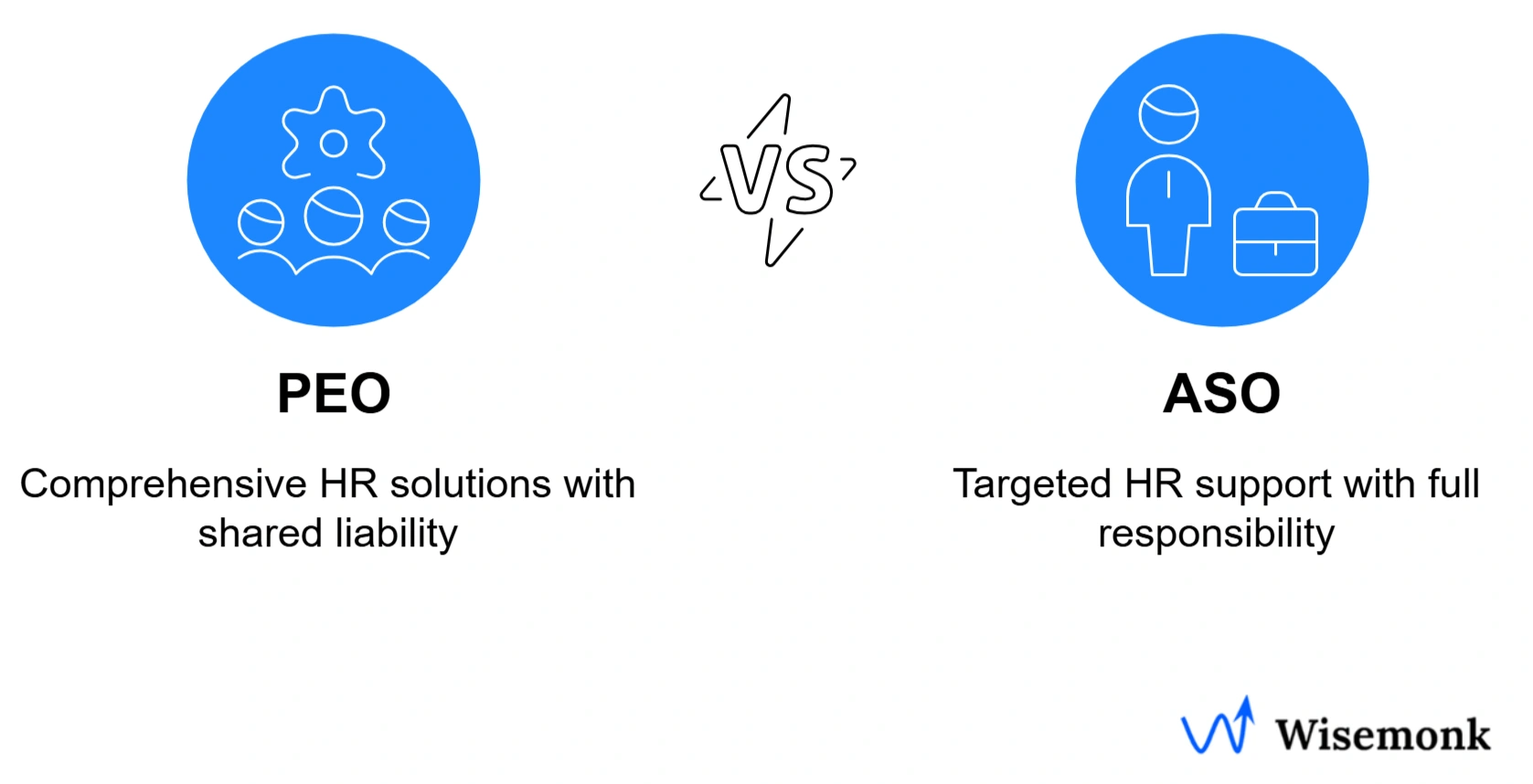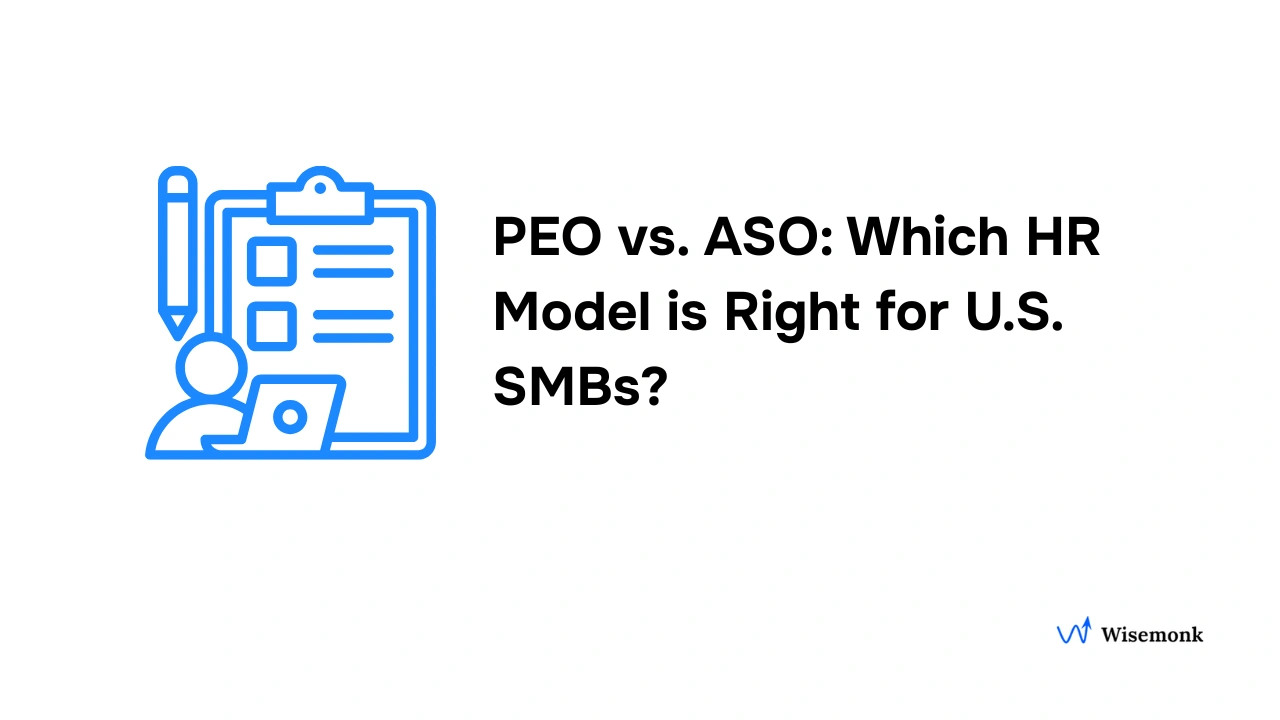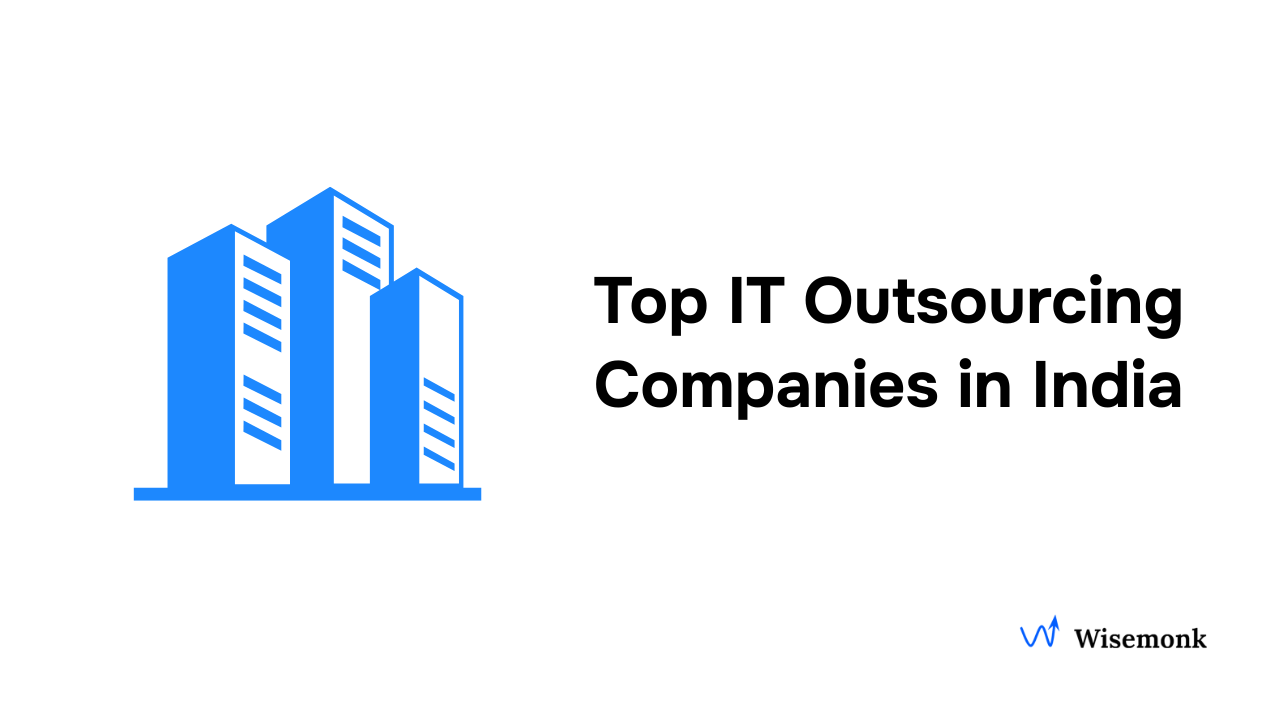- A PEO works through a co-employment arrangement, handling payroll taxes, benefits plans, workers’ compensation, and compliance, while sharing certain employer responsibilities.
- An ASO provides administrative services like payroll processing, benefits administration, and compliance support. The client company remains the sole employer and keeps full liability.
- The key difference between ASO and PEO is that a PEO operates under a co-employment model and acts as the employer of record for payroll taxes and benefits, while an ASO provides HR and payroll services without co-employment.
- Choose a PEO if you need access to pooled health insurance and group benefits plans, want shared liability, and prefer full-service HR outsourcing services.
- Choose an ASO if you have in-house HR staff, want administrative support without co-employment, and prefer to keep complete control and responsibility.
- When choosing between ASO and PEO consider factors like liability, access to competitive benefits, existing HR resources, budget, and the complexity of your HR functions across states.
Need help with your global expansion? Contact our team to learn how we can help streamline your global expansion.
Discover how Wisemonk creates impactful and reliable content.
Struggling to decide between a PEO vs ASO for your growing business? You're not alone, many business owners, HR leaders, and founders face this exact challenge when looking to outsource HR functions and streamline administrative tasks. The choice between a professional employer organization (PEO) and an administrative services organization (ASO) can significantly impact your company's HR operations, cost savings, compliance support, and overall growth trajectory. While both models offer payroll processing, benefits administration, and HR support, they differ fundamentally in co-employment relationships, risk management, and control.
In this guide, we'll explore the critical differences between ASO vs PEO models, break down pricing structures, examine when each makes sense for your business, and provide a practical decision framework to help you choose the right HR outsourcing solution for your specific needs.
What is a PEO?[toc=What is a PEO]
A professional employer organization (PEO) is a third-party provider that enters into a co-employment relationship with your business to handle HR functions, payroll processing, employee benefits administration, and regulatory compliance. The PEO becomes the legal employer of record for tax purposes while you maintain complete control over day-to-day operations.
According to NAPEO, approximately 173,000 small and mid-sized businesses in the U.S. currently partner with PEOs, representing over 4 million worksite employees.
Core PEO Services and Capabilities include:
- Payroll processing: Manages employee pay, deductions, and direct deposits under the PEO's EIN
- Benefits sponsorship: Provides group health insurance, dental, vision, 401(k), and life insurance with large-group pricing
- Workers compensation: Secures coverage, files claims, and manages workplace injury programs
- HR compliance: Ensures adherence to federal and state employment laws and ACA requirements
- Tax filing: Handles all federal, state, and local payroll tax compliance and quarterly filings
- Risk management: Offers workplace safety programs, employee handbooks, and liability mitigation
- Recruiting support: Assists with job descriptions, candidate screening, and new hire onboarding
- HR technology: Provides HRIS platforms for employee records, time tracking, and performance reviews
How does a PEO work?[toc=How PEO Works]
A PEO works by sharing employment responsibilities with your business under a co-employment arrangement. This doesn’t mean you lose control, it simply means the PEO becomes the “employer of record” for certain HR functions, while you remain the boss for day-to-day decisions.
Here’s how the process usually looks:
- Service agreement: You sign a contract that clearly defines which HR tasks the PEO handles and which stay with you.
- Payroll administration: The PEO runs payroll processing, files payroll taxes, and ensures compliance across states.
- Benefits administration: Your employees get access to pooled health insurance and other benefits plans negotiated by the PEO with insurance carriers.
- Workers’ compensation coverage: The PEO manages policies, claims, and compliance requirements.
- HR expertise: They provide HR services like handbooks, compliance checks, and support for administrative tasks.
The PEO takes on the heavy lifting of HR operations so you can save time, reduce risk, and focus on more strategic initiatives, while still keeping control over hiring, culture, and performance.
Best for: Small to mid-sized businesses (5-250 employees) without in-house HR staff that want comprehensive HR outsourcing and competitive benefits packages.
What are the pros & cons of a PEO?[toc=PEO Pros & Cons]
Companies choose a PEO when they want simplicity and shared responsibility. But it comes with trade-offs. Here is a clear view of the Pros & Cons of choosing a Professional Employer Organization for your business.
PEO Pros and Cons:
What is an ASO?[toc=What is an ASO]
An Administrative Services Organization (ASO) is a third-party provider that handles specific HR tasks like payroll processing, benefits administration support, and compliance advisory without entering into a co-employment relationship. Your client company remains the sole employer of record and retains full legal responsibility for your workforce.
Unlike PEOs, ASOs operate as independent vendors. They process administrative tasks under your company's Federal Employer Identification Number (FEIN) and give you complete control over HR decisions, vendor selection, and benefits plans.
Core ASO Services and Capabilities include:
- Payroll processing: Manages employee pay and deductions under your company's EIN
- Benefits administration support: Helps manage enrollment, carrier coordination, and employee communications
- HR consulting: Provides guidance on policies, procedures, and employee relations issues
- Compliance advisory: Offers recommendations on employment laws and regulatory requirements
- Tax preparation assistance: Calculates withholdings and prepares tax filings for your review
- HRIS technology: Provides access to HR platforms for employee data management
- Record-keeping: Maintains employee files, time tracking, and documentation systems
- Open enrollment support: Assists with annual benefits selection and employee education
How does an ASO work?[toc=How ASO Works]
An Administrative Services Organization (ASO) works by supporting your HR operations while you remain the official employer. Unlike a PEO model, there’s no co-employment arrangement, the client company remains fully responsible for its employees, policies, and compliance. The ASO acts more like a third-party vendor that takes on the back-office administrative tasks.
Here’s how an ASO typically works:
- Service agreement: You sign a contract that outlines which HR services the ASO will handle.
- Payroll administration: The ASO processes payroll, but you file payroll taxes under your company’s EIN.
- Benefits administration: You maintain your own benefits plans and insurance coverage, while the ASO helps manage enrollment, renewals, and communication with insurance brokers.
- Workers’ compensation: The ASO can assist with reporting and paperwork, but full responsibility for coverage and compliance stays with you.
- HR support: They provide templates, compliance guidance, and advice to help your in-house HR staff manage HR functions smoothly.
The ASO model gives you administrative support to ease the workload, while you keep complete control of employees and all employment-related responsibilities.
Best for: Established businesses (25+ employees) with in-house HR staff that want administrative support while maintaining full control over HR operations and decisions.
What are the pros & cons of an ASO model?[toc=ASO Pros & Cons]
From what we’ve seen, ASO services are appealing for businesses that want administrative services without giving up control. But the responsibility stays with you. Here is a clear view of the Pros & Cons of choosing an Administrative Services Organization for your business.
ASO Pros and Cons:
Both PEO and ASO aim to simplify HR operations, but they differ sharply in how much control, risk, and responsibility your business keeps. Let’s break down the key differences between the two models so you can see which one actually fits your growth strategy.
What Are the Key Differences Between PEO vs. ASO?[toc=PEO vs. ASO]
The main difference between PEO and ASO models is co-employment: a PEO becomes your legal employer of record and shares liability, while an ASO provides administrative support without co-employment, leaving you with full responsibility.
Here's how PEO vs ASO compare across seven critical factors:
To learn more about the cost of PEO, you can refer to our article on How much does a PEO cost?
Choose a PEO if you want comprehensive HR outsourcing with shared liability and competitive benefits. Choose an ASO if you have in-house HR staff and want to maintain full control while outsourcing administrative tasks.
ASO vs. PEO for Small Businesses: Which Should You Choose?[toc=What to Choose]
The right choice between PEO and ASO depends on your company size, HR capabilities, risk tolerance, and growth stage. Here's how to decide which model fits your business needs.

For a small business, the choice between PEO and ASO hinges on your existing internal HR capacity, desire for control, budget, and appetite for risk.
- Choose a PEO for comprehensive, full-service HR management, shared liability, and access to premium large-group benefits at lower costs.
- Choose an ASO if you have an in-house HR team, want to retain full control over HR processes and liability, and need flexible à la carte administrative support for specific tasks.
When to Choose a PEO?[toc=When Choose PEO]
A PEO is ideal if your small business:
- Lacks a dedicated HR department or manager – The PEO acts as your full HR team, managing payroll processing, compliance, and benefits administration so you can focus on core business functions.
- Wants to offer competitive employee benefits – PEOs pool employees from multiple companies to negotiate better health insurance, retirement plans, and workers compensation rates that you couldn't access independently.
- Seeks to minimize legal risk – The co-employment model means the PEO shares liability for compliance with federal and state employment laws, reducing your exposure to costly fines and lawsuits.
- Operates in multiple states or plans rapid expansion – PEOs manage compliance with diverse state regulations and multi-state payroll tax reporting, simplifying geographic growth.
- Prefers a bundled, all-in-one solution – PEOs offer comprehensive, integrated HR services and technology platforms as standard packages with single-vendor simplicity.
When to Choose an ASO?[toc=When Choose ASO]
An ASO is a better fit if your small business:
- Already has in-house HR staff – An ASO provides administrative support for routine tasks, allowing your existing HR team to focus on strategic initiatives, company culture, and employee development.
- Wants to retain full control and liability – With an ASO, you remain the sole legal and tax employer, keeping complete control over all HR decisions, vendors, and policies.
- Needs flexible, specific services – ASOs operate on an à la carte model, allowing you to select only the services you need like payroll processing or benefits administration support.
- Prioritizes lower upfront costs and pricing flexibility – ASOs generally charge $50-$100 per employee monthly with flat rates, avoiding the percentage-of-payroll model that increases with higher salaries.
- Already has suitable benefits plans – If you're satisfied with your current insurance carriers and brokers, an ASO simply administers them rather than requiring you to switch to pre-negotiated options.
Decision Framework: How to Choose Between PEO and ASO[toc=How to Choose]
HR Team Assessment
- If you lack dedicated HR staff or struggle with multi-state compliance, a PEO offers full support.
- If you have an HR team that can manage compliance and employment laws, consider an ASO.
Company Profile
- If your business has fewer than 75 employees or is experiencing rapid growth, a PEO is a better fit.
- Larger or more stable businesses with an established HR team will benefit from an ASO.
Risk & Compliance
- For shared liability and compliance support, go with a PEO.
- If your company prefers to manage its own compliance and liability, choose an ASO.
Budget & Benefits
- If offering competitive benefits is essential for recruiting, a PEO is the right choice.
- If your budget is tighter and you have existing benefits plans, an ASO will give you more flexibility.
Control Preferences
- If you need control over HR policies and vendor selection, opt for an ASO.
- If you're comfortable with standardized HR processes, a PEO is ideal.
Decision Outcome:
Answer “PEO” to 5 or more questions? Choose a PEO for comprehensive support.
Answer “ASO” to 5 or more? An ASO offers flexibility and control.
What are common misconceptions about PEO and ASO in HR outsourcing?[toc=Misconceptions]
In our experience as a leading Employer of Record, many business owners confuse a PEO and ASO, especially when it comes to how human resources outsourcing really works. Misunderstandings usually show up around liability, health insurance, and control. Let’s clear a few up.
Common misconceptions:
- “Using a PEO means I lose control of my employees.”
Not true. Even in a co-employment arrangement, the client company remains in charge of hiring, firing, pay decisions, and company culture. The PEO takes only the administrative services load. - “An ASO handles liability the same way as a PEO.”
Wrong. Under the ASO vs PEO setup, the administrative services organization doesn’t assume liability. You keep full responsibility for compliance, payroll taxes, and risk. - “PEO and ASO both give me access to better health insurance.”
Only partly true. With a PEO model, you gain access to pooled insurance plans through large insurance carriers, often at lower rates. An ASO simply helps you manage your existing benefits plans with insurance brokers. - “PEO and ASO are the same type of HR outsourcing services.”
They’re not. PEO services cover a full suite of HR services, while an ASO provides administrative support for selected HR functions.
A clear grasp of the key differences in liability, benefits, and control will help you choose the right partner for your HR needs.
How does Wisemonk help?[toc=How Wisemonk Helps]
Wisemonk is a leading Employer of Record (EOR), helping global companies hire, pay, and manage talent without setting up a local entity. We go beyond what a typical PEO or ASO would cover by offering a complete, India-expertise solution.
Here’s how we help businesses your expansion:
- We help you source mid to senior-level talent from India’s top companies and onboard them quickly.
- We run payroll accurately, manage taxes, and take care of PF, ESI, and Gratuity in full compliance with Indian laws.
- We provide employees with access to competitive health insurance, retirement plans, and local benefits.
- We set up equipment and infrastructure so your hires can start contributing from day one.
- We carry out background verification checks to secure every hire.
- We protect your IP with compliant contracts and NDAs tailored to Indian regulations.
While India is our core strength, we understand that many businesses have global ambitions. That’s why we also support clients expanding into key markets like the United Kingdom, the United States and beyond. With Wisemonk, you get a reliable partner for your India operations and your broader global hiring journey.
Ready to build your world-class team in India, or need guidance for hiring internationally? Connect with Wisemonk and let’s make your global expansion effortless.




.png)

.webp)